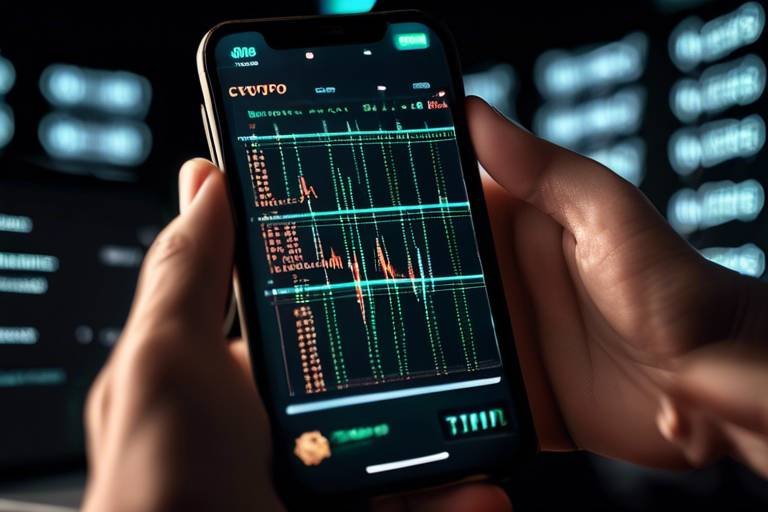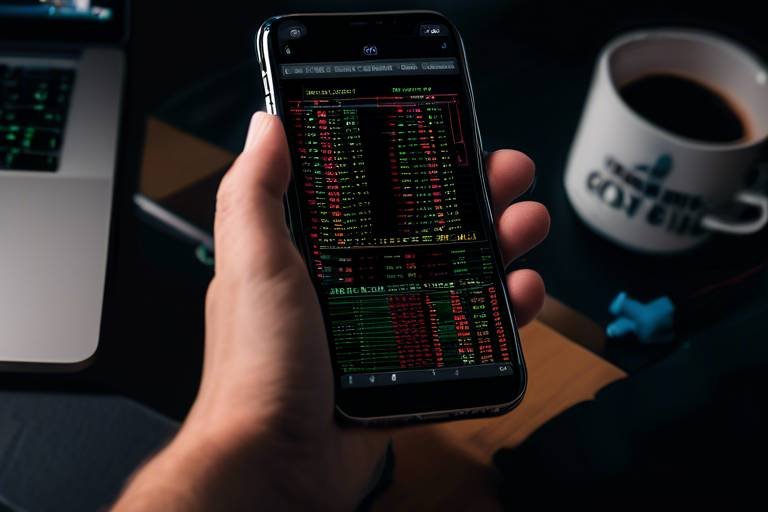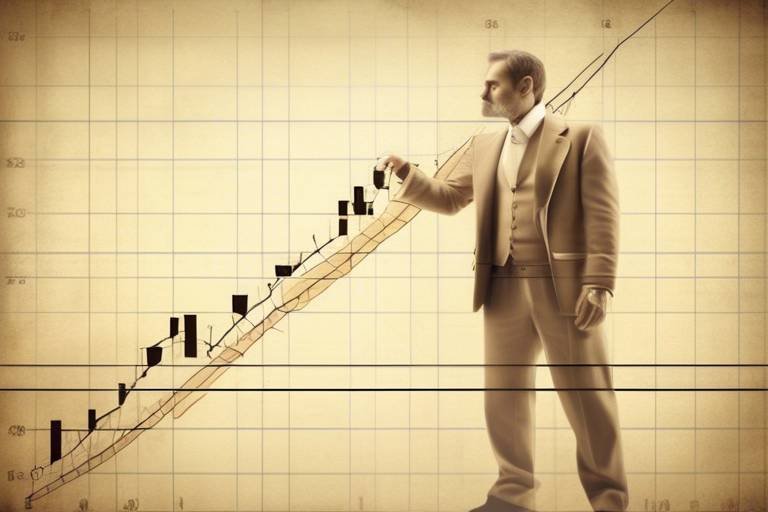The Best Indicators for Trading Cryptocurrency Effectively
In the fast-paced world of cryptocurrency trading, making informed decisions is crucial to maximizing your profits and minimizing losses. With the market constantly fluctuating, traders need to rely on reliable indicators that can guide them through the chaos. These indicators serve as signals that help you interpret market trends, understand price movements, and assess trading volumes. They are like the compass in a sailor's hand, directing you toward profitable waters while avoiding treacherous tides. In this article, we will explore the key indicators that can significantly enhance your trading strategy, enabling you to navigate the volatile cryptocurrency landscape with confidence.
Cryptocurrency indicators are essential tools that allow traders to analyze market trends, price movements, and trading volume. Imagine trying to find your way through a dense fog without a flashlight; that’s what trading in the dark without indicators feels like. These indicators help illuminate the path, making it easier to make educated trading choices. By utilizing indicators, traders can identify patterns that may not be immediately visible, allowing them to anticipate market movements and make timely decisions. Whether you're a seasoned trader or just starting, understanding these indicators is fundamental to developing a robust trading strategy.
There are various types of technical indicators, each serving a unique purpose in the trading process. From trend indicators that help identify the direction of the market to momentum indicators that measure the strength of price movements, these tools can provide invaluable insights. Let’s take a closer look at some of the most common indicators and how they can be utilized for effective trading.
Moving averages are one of the most popular tools in a trader's arsenal. They smooth out price data to identify trends over time, acting as a buffer against the noise of daily price fluctuations. By plotting a moving average on a chart, traders can easily visualize the overall direction of the market. There are two main types of moving averages: the Simple Moving Average (SMA) and the Exponential Moving Average (EMA). Each serves its purpose, and understanding their differences can help you signal potential entry and exit points.
The Simple Moving Average is calculated by taking the average price of an asset over a specific period. For example, a 10-day SMA adds up the closing prices of the last ten days and divides by ten. This indicator is widely used because it provides a straightforward view of the market's direction. However, it can lag behind current prices, which is why understanding its application in identifying market trends is crucial for effective trading.
On the other hand, the Exponential Moving Average gives more weight to recent prices, making it more responsive to new information. This can be particularly advantageous in a rapidly changing market like cryptocurrency. Traders often prefer the EMA for short-term trading strategies because it reacts more quickly to price changes, thus providing timely signals for buying or selling. Understanding how to leverage the EMA can significantly enhance your trading strategy.
The Relative Strength Index is a momentum oscillator that measures the speed and change of price movements. It ranges from 0 to 100 and is often used to identify overbought or oversold conditions in the market. A reading above 70 typically indicates that an asset may be overbought, while a reading below 30 suggests it might be oversold. By interpreting RSI values effectively, traders can make informed decisions about when to enter or exit a position, enhancing their chances of success.
Volume indicators provide insights into the strength of a price movement. They can confirm trends and signal potential reversals in the market. For instance, if a price movement is accompanied by high trading volume, it is more likely to be sustainable. Conversely, a price rise with low volume may indicate a lack of conviction among traders. Understanding volume dynamics is essential for making educated trading choices.
On-Balance Volume combines price and volume to indicate buying or selling pressure. If the price increases and the OBV also rises, it suggests that buyers are in control. Conversely, if the price rises but the OBV falls, it may indicate that sellers are gaining strength. By using OBV effectively, traders can predict future price movements and make more informed decisions.
The Accumulation/Distribution Line helps traders understand the flow of money into and out of an asset. This indicator takes both price and volume into account, providing a clearer picture of market sentiment. By analyzing the A/D line, traders can identify potential market trends and reversals, making it a crucial tool in their trading toolkit.
Using multiple indicators together can enhance trading strategies significantly. By combining different indicators, traders can create a more comprehensive view of the market, leading to more reliable trading signals. For example, a trader might use the RSI to identify overbought conditions while confirming the trend with moving averages. This layered approach can provide a safety net, helping to mitigate risks and improve overall trading performance.
- What are cryptocurrency indicators? - Cryptocurrency indicators are tools that help traders analyze market trends, price movements, and trading volume.
- Why are moving averages important? - Moving averages help traders identify trends and potential entry and exit points by smoothing out price data.
- How does the RSI work? - The Relative Strength Index measures the speed and change of price movements, indicating overbought or oversold conditions.
- Can I use multiple indicators at once? - Yes, combining different indicators can provide a more comprehensive view of market conditions and improve trading strategies.

Understanding Cryptocurrency Indicators
When diving into the world of cryptocurrency trading, it's crucial to equip yourself with the right tools. Cryptocurrency indicators are like the compass for a sailor lost at sea; they guide you through the turbulent waters of market fluctuations. These indicators provide traders with vital insights into market trends, price movements, and trading volumes, enabling them to make informed decisions. Without these tools, navigating the volatile crypto landscape can feel like trying to find your way in the dark without a flashlight.
So, why are these indicators so important? First off, they help you understand the market's behavior and sentiment. By analyzing historical data, traders can identify patterns that might repeat themselves, allowing them to anticipate future price movements. Think of it like watching a movie you've seen before; you already know the plot twists and can prepare for them. Additionally, indicators can assist in timing your trades, ensuring you buy low and sell high, which is the ultimate goal in trading.
There are a variety of indicators out there, each with its own unique function and purpose. Some are designed to identify trends, while others focus on momentum or volatility. Here’s a quick breakdown:
- Trend Indicators: These help you determine the direction of the market, whether it's bullish (upward) or bearish (downward).
- Momentum Indicators: These measure the speed of price movements, helping you identify potential reversals.
- Volume Indicators: These assess the strength of a price movement based on trading volume, providing clues about the sustainability of trends.
In essence, mastering these indicators is like learning the language of the market. Once you understand what they are telling you, you can make better trading decisions. For instance, if a trend indicator shows a strong upward movement while a momentum indicator suggests overbought conditions, you might reconsider your buying strategy. It's about piecing together the puzzle to see the bigger picture.
Moreover, it's essential to remember that no single indicator is foolproof. Relying solely on one tool can lead to misinterpretations and potential losses. Instead, successful traders often combine multiple indicators to create a comprehensive trading strategy. This multifaceted approach not only increases the reliability of the signals but also provides a broader perspective on market dynamics.
In conclusion, understanding cryptocurrency indicators is a fundamental step for any trader looking to navigate the complex world of digital assets. By leveraging these tools, you can enhance your analysis, make informed decisions, and ultimately improve your trading outcomes. So, are you ready to dive deeper into the types of indicators that can elevate your trading game?

Types of Technical Indicators
When it comes to trading cryptocurrency, understanding the is crucial for developing a successful strategy. These indicators serve as a compass, guiding traders through the often turbulent waters of the cryptocurrency market. By leveraging these tools, traders can make informed decisions, identify trends, and ultimately enhance their chances of profitability.
Technical indicators can be broadly classified into two categories: trend indicators and momentum indicators. Each type plays a unique role in analyzing market behavior. Trend indicators, like moving averages, help traders identify the direction of the market—whether it’s trending upwards, downwards, or sideways. On the other hand, momentum indicators, such as the Relative Strength Index (RSI), measure the speed and strength of price movements, indicating whether a cryptocurrency is overbought or oversold.
To give you a clearer picture, let’s dive a little deeper into some of the most common technical indicators:
| Indicator | Type | Purpose |
|---|---|---|
| Moving Averages | Trend Indicator | Identify average price over a specific period to determine market direction. |
| Relative Strength Index (RSI) | Momentum Indicator | Measure speed and change of price movements to identify overbought or oversold conditions. |
| MACD (Moving Average Convergence Divergence) | Trend/Momentum Indicator | Indicate changes in momentum by comparing two moving averages. |
| Bollinger Bands | Volatility Indicator | Assess market volatility and identify potential overbought or oversold conditions. |
Using these indicators effectively can significantly improve your trading strategy. For instance, combining a trend indicator like the Simple Moving Average (SMA) with a momentum indicator such as the RSI can provide a more comprehensive view of the market. When the SMA indicates an upward trend and the RSI shows that the asset is not overbought, it could be a strong signal to enter a trade.
However, it’s essential to remember that no single indicator is foolproof. The cryptocurrency market is notoriously volatile, and relying solely on one indicator can lead to misguided decisions. Instead, consider using a combination of indicators to create a more robust trading strategy. This approach allows you to cross-verify signals and reduce the risk of false positives.
In conclusion, understanding the various types of technical indicators and how they interact with each other is a vital aspect of successful cryptocurrency trading. By familiarizing yourself with these tools, you can navigate the market more effectively and make informed decisions that align with your trading goals.

Moving Averages
Moving averages are like the compass of the trading world, helping you navigate through the sometimes turbulent seas of cryptocurrency prices. They serve as a vital tool for traders by smoothing out price data over a specific period, which can significantly aid in identifying trends. When you look at a price chart, it can often feel like a chaotic jumble of numbers and fluctuations. This is where moving averages come into play, allowing you to filter out the noise and focus on the underlying trend. Imagine trying to find your way through a dense forest; moving averages clear the path, making it easier to see where you’re headed.
There are two primary types of moving averages that traders commonly use: the Simple Moving Average (SMA) and the Exponential Moving Average (EMA). Each has its unique characteristics and applications, making them suitable for different trading strategies. Understanding these differences can be the key to unlocking your trading potential.
The Simple Moving Average (SMA) is calculated by taking the average of a set number of past prices. For instance, if you want to calculate the 10-day SMA, you would add up the closing prices of the last 10 days and then divide by 10. This gives you a single value that represents the average price over that period. While the SMA is straightforward and easy to understand, it can lag behind current market conditions since it gives equal weight to all prices in the period. This lag can sometimes lead traders to make decisions based on outdated information.
On the other hand, the Exponential Moving Average (EMA) takes it a step further by giving more weight to recent prices. This means that the EMA reacts more quickly to price changes than the SMA, making it a favorite among traders who want to capitalize on short-term movements. The formula for the EMA is a bit more complex, but the essence is that it helps traders stay ahead of the curve. For example, if you are using a 10-day EMA, the most recent prices will influence the average more than the prices from ten days ago. This responsiveness can be crucial in a volatile market like cryptocurrency, where prices can change rapidly.
To illustrate the differences between SMA and EMA, here's a quick comparison table:
| Feature | Simple Moving Average (SMA) | Exponential Moving Average (EMA) |
|---|---|---|
| Weighting | Equal weight to all prices | More weight to recent prices |
| Speed of Reaction | Slower to react to price changes | Faster to react to price changes |
| Use Case | Long-term trends | Short-term trends |
In conclusion, moving averages are essential for any cryptocurrency trader looking to enhance their trading strategy. By understanding the differences between SMA and EMA, you can make informed decisions about when to enter or exit a trade. Whether you prefer the simplicity of the SMA or the responsiveness of the EMA, incorporating these tools into your trading arsenal can help you navigate the unpredictable waters of cryptocurrency trading with greater confidence.

Simple Moving Average (SMA)
The is one of the most foundational tools in the arsenal of a cryptocurrency trader. Think of it as the calm amidst the storm of price fluctuations. By averaging the prices over a specific period, the SMA helps to smooth out the noise, allowing traders to see the underlying trend more clearly. Imagine trying to listen to a conversation at a crowded party; the SMA filters out the background chatter, letting you focus on the key points that matter.
Calculating the SMA is quite straightforward. You simply add up the closing prices of a cryptocurrency over a designated number of periods and then divide that sum by the number of periods. For instance, if you wanted to calculate a 5-day SMA, you would take the closing prices of the last five days, sum them up, and divide by five. This simple formula can be expressed as:
SMA (P1 + P2 + P3 + P4 + P5) / 5
Where P1 to P5 are the closing prices for each of the five days. The SMA can be calculated for any time frame, whether it’s days, weeks, or even months, depending on your trading strategy.
Now, why should you care about the SMA? Well, it serves multiple purposes. First and foremost, it helps identify the direction of the trend. If the SMA is sloping upwards, it indicates that the market is in a bullish phase, while a downward slope suggests bearish conditions. Moreover, traders often use the SMA to determine potential entry and exit points. For instance, a common strategy is to buy when the price crosses above the SMA and sell when it crosses below. This crossover strategy can be a powerful signal in the highly volatile crypto market.
However, like any tool, the SMA is not without its limitations. One of the primary drawbacks is that it is a lagging indicator, meaning it reacts to price changes rather than predicting them. This lag can sometimes lead to missed opportunities, especially in fast-moving markets. To counter this, many traders use the SMA in conjunction with other indicators, such as the Exponential Moving Average (EMA), which reacts more quickly to price changes.
In summary, the Simple Moving Average is a vital component of technical analysis that can help you navigate the choppy waters of cryptocurrency trading. By providing a clearer view of market trends and potential trading signals, it empowers you to make more informed decisions. As you dive deeper into the world of crypto, remember that the SMA is just one piece of the puzzle, but it’s a piece that can significantly enhance your trading strategy.
- What is the difference between SMA and EMA?
The SMA gives equal weight to all prices in the period, while the EMA gives more weight to recent prices, making it more responsive to new information. - How long should I set my SMA period?
This depends on your trading strategy. Shorter SMAs (like 10 or 20 days) can be more volatile, while longer SMAs (like 50 or 200 days) provide a smoother trend line. - Can I use SMA for day trading?
Yes, many day traders use short-term SMAs to identify quick entry and exit points in the market.

Exponential Moving Average (EMA)
The is a powerful tool in the arsenal of any cryptocurrency trader. Unlike the Simple Moving Average (SMA), which treats all price data equally, the EMA gives more weight to recent prices. This characteristic makes it particularly useful for traders who want to respond quickly to market changes. Imagine you're in a race; the EMA is like a sprinter who reacts instantly to the starting gun, while the SMA is more like a slow-moving train, taking time to gather speed. This responsiveness can make a significant difference when you're trying to capitalize on fleeting trading opportunities.
Calculating the EMA involves a bit of math, but the good news is that most trading platforms do this for you. The formula incorporates the previous EMA and the current price, allowing it to adjust more rapidly than the SMA. This means that if a cryptocurrency's price suddenly spikes, the EMA will reflect that change much quicker, giving traders a potential edge. To calculate the EMA, you can use the following formula:
EMA (Current Price * K) + (Previous EMA * (1 - K)) where K 2 / (N + 1) N the number of periods
Traders often use the EMA in conjunction with other indicators to confirm trends. For instance, if the price is above the EMA, it might indicate a bullish trend, while a price below the EMA could suggest a bearish trend. This is where the magic happens; by combining the EMA with other indicators like the Relative Strength Index (RSI) or Moving Average Convergence Divergence (MACD), traders can gain a more comprehensive view of the market.
Moreover, the EMA can also serve as a dynamic support or resistance level. When the price approaches the EMA from above, it may find support, while a drop below the EMA could signal resistance. This behavior can be particularly valuable for setting stop-loss levels or determining entry and exit points in your trading strategy.
In summary, the Exponential Moving Average is not just a number on a chart; it's a dynamic indicator that can help traders navigate the often turbulent waters of cryptocurrency trading. By providing a clearer picture of recent price action, the EMA allows traders to make more informed decisions, potentially leading to increased profits and reduced losses.
- What is the main advantage of using EMA over SMA? The EMA reacts more quickly to price changes, making it more suitable for volatile markets like cryptocurrencies.
- How can I use EMA in my trading strategy? You can use EMA to identify trends, set stop-loss levels, and confirm signals from other indicators.
- Is there a specific period I should use for EMA? Common periods include 9, 12, and 26 days, but it ultimately depends on your trading strategy and goals.

Relative Strength Index (RSI)
The is a powerful momentum oscillator that traders use to gauge the speed and change of price movements in the cryptocurrency market. Imagine you're on a roller coaster; the RSI helps you understand how steep the ride is and whether you're headed for a thrilling drop or a smooth ascent. This indicator ranges from 0 to 100, and it’s primarily used to identify overbought or oversold conditions in a market, which can be crucial for making informed trading decisions.
Typically, an RSI value above 70 indicates that a cryptocurrency is overbought, suggesting that it may be due for a price correction. Conversely, an RSI below 30 signals that an asset is oversold, hinting at a potential price increase. But don't just take these levels at face value; they should be interpreted in the context of the overall market conditions. For example, in a strong uptrend, the RSI can remain above 70 for extended periods, suggesting that the asset is still gaining momentum. So, while the RSI is a valuable tool, it's essential to consider other factors in your trading strategy.
To better understand how to use the RSI, let’s look at a simple table that outlines the key RSI levels and their implications:
| RSI Value | Market Condition | Implication |
|---|---|---|
| 0 - 30 | Oversold | Potential buying opportunity |
| 30 - 50 | Neutral | Market is consolidating |
| 50 - 70 | Neutral to Strong | Potential for upward movement |
| 70 - 100 | Overbought | Potential selling opportunity |
When using the RSI, it’s also beneficial to look for divergences between the RSI and the price action. For instance, if the price of a cryptocurrency is making new highs while the RSI is failing to reach new highs, this could indicate a weakening trend and a potential reversal. Think of it as a warning light on your dashboard; it’s telling you to pay attention to what’s happening beneath the surface!
In conclusion, the RSI is not just a standalone indicator; it should be part of a broader trading strategy that incorporates various tools and analysis methods. By understanding how to interpret the RSI correctly, traders can enhance their decision-making process and potentially increase their profitability in the ever-volatile cryptocurrency market.

Volume Indicators
When it comes to trading cryptocurrencies, understanding is like having a compass in a dense forest. They provide crucial insights into the strength of price movements, helping traders decipher whether a trend is genuine or just a fleeting illusion. Imagine you're at a concert; the louder the crowd cheers, the more you can feel the energy in the air. Similarly, volume indicators measure the intensity of market activity, allowing you to gauge the strength behind price changes.
Volume indicators are vital because they help confirm trends and signal potential reversals. For example, if a cryptocurrency is experiencing a price surge accompanied by high trading volume, it often indicates strong buying interest, suggesting that the upward trend may continue. On the other hand, if prices are rising but the volume is low, it could signal a lack of conviction among buyers, hinting that a reversal might be on the horizon.
Two of the most popular volume indicators are the On-Balance Volume (OBV) and the Accumulation/Distribution Line. Each of these indicators offers unique insights that can enhance your trading strategy. Let's take a closer look at these two indicators:
| Indicator | Description | Use Case |
|---|---|---|
| On-Balance Volume (OBV) | Combines price and volume to indicate buying or selling pressure. | Can predict future price movements based on volume trends. |
| Accumulation/Distribution Line | Tracks the flow of money into and out of an asset. | Helps identify market trends and potential reversals. |
By analyzing these indicators, traders can make more informed decisions. For instance, if the OBV is rising while the price is also increasing, it suggests that the upward movement is supported by strong buying pressure. Conversely, if the OBV is declining while prices rise, it could indicate that the trend is losing steam, and a reversal might be imminent.
Furthermore, the Accumulation/Distribution Line provides a deeper understanding of market sentiment. When this line is trending upwards, it indicates that more money is flowing into the asset, suggesting accumulation. On the flip side, a downward trend can signal distribution, where traders are selling off their holdings. This nuanced understanding of volume dynamics can be the difference between a successful trade and a costly mistake.
In summary, volume indicators are essential tools in a trader's arsenal, offering insights into market strength and potential reversals. By combining these indicators with other technical analysis tools, you can create a robust trading strategy that adapts to the ever-changing cryptocurrency landscape.

On-Balance Volume (OBV)
The is a powerful indicator that combines price and volume to provide traders with a clearer picture of market sentiment. Imagine a scale where every time a cryptocurrency's price rises, the weight shifts to the buying side, and when it falls, it shifts to the selling side. This is essentially what OBV does—it tracks the cumulative volume of trades and helps you gauge whether the price movement is supported by strong buying or selling pressure.
To understand how OBV works, consider this: if the price of Bitcoin increases while the OBV also rises, it indicates that the increase is backed by a significant volume of buying activity. Conversely, if the price rises but the OBV falls, it suggests that the upward movement may not be sustainable, as there isn’t enough buying pressure to support it. This makes OBV a fantastic tool for identifying potential price trends and reversals.
Calculating OBV is straightforward. Here’s the formula:
| Condition | OBV Calculation |
|---|---|
| If today's closing price > yesterday's closing price | OBV Previous OBV + Today's Volume |
| If today's closing price < yesterday's closing price | OBV Previous OBV - Today's Volume |
| If today's closing price yesterday's closing price | OBV Previous OBV |
This simple yet effective calculation allows traders to visualize trends over time. When you plot OBV on a chart alongside the price of a cryptocurrency, you can often see divergences that are key to making informed trading decisions. For instance, if you notice that the price is making new highs while the OBV is making lower highs, this could signal a potential reversal, indicating that the upward trend may be losing momentum.
Moreover, OBV can be used in conjunction with other indicators to enhance your trading strategy. For example, pairing OBV with moving averages can help confirm trends. If both indicators are aligned, it’s a strong signal to consider entering a trade. However, if they diverge, it might be time to reevaluate your position. The beauty of OBV lies in its ability to provide a comprehensive view of the market, helping you make more informed decisions.
In summary, the On-Balance Volume indicator is an essential tool for any cryptocurrency trader. By understanding how to read and interpret OBV, you can gain valuable insights into market trends, identify potential reversals, and ultimately enhance your trading strategy. Remember, the key to successful trading is not just about knowing when to buy or sell, but understanding the underlying market dynamics that drive those decisions.
- What is the main purpose of OBV? OBV helps traders determine the strength of price movements based on volume, indicating whether a trend is likely to continue or reverse.
- How can I use OBV in my trading strategy? You can use OBV to confirm trends, identify potential reversals, and combine it with other indicators for a more robust trading strategy.
- Is OBV suitable for all cryptocurrencies? Yes, OBV can be applied to any cryptocurrency, but its effectiveness can vary based on market conditions and trading volumes.

Accumulation/Distribution Line
The Accumulation/Distribution Line (A/D Line) is a powerful tool that traders use to gauge the flow of money into and out of a cryptocurrency. It combines both price and volume to provide a clearer picture of market activity. Think of it as a pulse check for the market—when the A/D Line is rising, it indicates that more money is flowing into the asset, suggesting accumulation. Conversely, when the line is falling, it signals distribution, or selling pressure. This dual focus on price and volume makes the A/D Line a valuable indicator for identifying potential trend reversals and confirming existing trends.
To understand how the A/D Line works, consider this: if a cryptocurrency closes higher on a day with significant trading volume, it suggests that buyers are in control. This scenario would contribute positively to the A/D Line. On the other hand, if the price closes lower on high volume, it reflects selling pressure, which would pull the A/D Line down. By analyzing these movements, traders can make more informed decisions about when to enter or exit trades.
Here's a simplified formula for calculating the A/D Line:
| Step | Calculation |
|---|---|
| 1 | Calculate the Money Flow Multiplier: (Close - Low) - (High - Close) / (High - Low) |
| 2 | Multiply the Money Flow Multiplier by the Volume for that period. |
| 3 | Add the result to the previous A/D Line value. |
By continuously tracking this line, traders can spot divergences between price movements and the A/D Line itself. For instance, if the price of a cryptocurrency is making new highs, but the A/D Line is not following suit, it could indicate a weakening trend and a potential reversal. This divergence can serve as an early warning sign, allowing traders to adjust their strategies accordingly.
In summary, the Accumulation/Distribution Line is not just about numbers; it's about understanding the underlying market sentiment. By keeping an eye on this indicator, you can better navigate the often turbulent waters of cryptocurrency trading. The A/D Line provides a unique perspective that complements other technical indicators, making it an essential tool in any trader's arsenal.
- What is the main purpose of the Accumulation/Distribution Line?
The A/D Line helps traders identify the flow of money in and out of an asset, indicating potential accumulation or distribution. - How do I interpret the A/D Line?
A rising A/D Line suggests accumulation, while a falling line indicates distribution. Look for divergences between price and the A/D Line for potential trend reversals. - Can the A/D Line be used alone for trading decisions?
While it’s a valuable tool, it’s best used in conjunction with other indicators to confirm trends and signals.

Combining Indicators for Better Strategies
When it comes to trading cryptocurrency, relying on a single indicator can often feel like trying to navigate a stormy sea with just one oar. To truly harness the power of the market, it's essential to combine multiple indicators to create a more robust trading strategy. This approach not only enhances your decision-making process but also provides a clearer picture of market dynamics. By using a combination of indicators, you can confirm signals and reduce the likelihood of false positives that can lead to costly mistakes.
For instance, consider blending a Moving Average with the Relative Strength Index (RSI). The Moving Average can help you identify the overall trend, while the RSI can indicate whether the asset is overbought or oversold. When both indicators align, you can have greater confidence in your trading decision. Imagine you see a bullish trend in the Moving Average, and the RSI drops below 30, suggesting the asset is oversold. This could be a strong signal to buy, as you're not just relying on one piece of information but rather a confluence of data points that support your strategy.
Another effective combination is using Volume Indicators alongside price action indicators. For example, the On-Balance Volume (OBV) can provide insights into whether the price movement is supported by strong buying or selling pressure. If you notice a price increase accompanied by rising OBV, it indicates that the trend is likely to continue. However, if the price rises while OBV declines, it might signal a potential reversal. This synergy between price and volume indicators can significantly enhance your trading decisions.
It's also crucial to customize your combinations based on your trading style. Day traders might prefer short-term indicators like the Exponential Moving Average (EMA) paired with the MACD (Moving Average Convergence Divergence) for quick entry and exit points, while long-term investors might find strength in combining the Simple Moving Average (SMA) with the Accumulation/Distribution Line to gauge the overall market sentiment over time. The key is to test different combinations and see what works best for you.
To illustrate the effectiveness of combining indicators, let's take a look at the following table that outlines some popular combinations and their potential benefits:
| Indicator Combination | Purpose |
|---|---|
| Moving Average + RSI | Identifies trend direction and overbought/oversold conditions. |
| OBV + Price Action | Confirms price movements with volume support. |
| SMA + Accumulation/Distribution Line | Analyzes long-term trends and market sentiment. |
| EMA + MACD | Provides quick signals for short-term trading. |
In conclusion, the art of combining indicators is akin to painting a masterpiece. Each indicator adds its unique color to the canvas, creating a more vibrant and detailed picture of the market. As you experiment with different combinations, remember to keep an eye on market conditions and adjust your strategies accordingly. The beauty of trading lies in its dynamism, and by leveraging multiple indicators, you can navigate the cryptocurrency waters with confidence and precision.
Q1: Can I use any indicators together?
A1: While you can technically use any indicators together, it's essential to choose those that complement each other. Look for indicators that provide different types of information, such as trend direction and momentum.
Q2: How do I know which indicators to combine?
A2: Start by identifying your trading style and goals. From there, experiment with different combinations to see which ones provide the most reliable signals for your strategy.
Q3: Is there a risk in relying too much on indicators?
A3: Yes, over-reliance on indicators can lead to analysis paralysis. It's crucial to balance indicator analysis with market news and events to make informed decisions.
Q4: How often should I adjust my indicators?
A4: Regularly review your indicators, especially in volatile markets. Adjust them based on changing market conditions or your evolving trading strategy.
Frequently Asked Questions
- What are cryptocurrency indicators?
Cryptocurrency indicators are tools that traders use to analyze market trends, price movements, and trading volume. They help in making informed decisions, especially in the volatile cryptocurrency market. By understanding these indicators, traders can better navigate their strategies and potentially maximize their profits.
- How do moving averages work in trading?
Moving averages smooth out price data over a specific period, helping traders identify trends. There are different types, like the Simple Moving Average (SMA) and the Exponential Moving Average (EMA). The SMA gives equal weight to all prices, while the EMA gives more weight to recent prices, making it more responsive to new information.
- What is the Relative Strength Index (RSI) and how is it used?
The RSI is a momentum oscillator that measures the speed and change of price movements. It ranges from 0 to 100 and is typically used to identify overbought or oversold conditions in a market. Traders often look for values above 70 as overbought and below 30 as oversold to make trading decisions.
- Why are volume indicators important?
Volume indicators provide insights into the strength of price movements. They help confirm trends and can signal potential reversals in the market. High trading volume can indicate strong interest in an asset, while low volume may suggest a lack of conviction in price movements.
- How can I combine different indicators for better trading strategies?
Combining multiple indicators can enhance the reliability of trading signals. For instance, using both moving averages and volume indicators can provide a more comprehensive view of market conditions. By looking at the interplay between different indicators, traders can make more informed decisions and improve their chances of success.


















